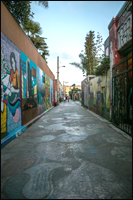On Saturday, May 28, 2022 in collaboration with SOMCAN, SoMa Pilipinas, and the African American Arts & Cultural District, CAMP hosted a celebration for Claire Amable’s and Lorenzo Tamayo-Lee’s new mural Frisco Rise featuring:
DJ Jenset
Emcee Claire
Welcome by Kyoko Sato
Land Acknowledgement by Marina and Elaine
words by Kyoko Sato
words by Lian Ladia
words by Claire Amable
words by Eleanore Fernandez, Manilatown Heritage Foundation
words by Ramon Bonifacio, South of Market Community Action Network (SOMCAN)
performance by Darren Garza from Parangal Dance Company
words by Coach Lilla, director of Feline Finesse and representing San Francisco African American Arts & Cultural District
performance by Feline Finesse
words by Mr. Tim, United Playaz
performance by Mavy-E, SoMa Pilipinas
Live silk screen printing by the San Francisco Poster Syndicate
Food by Irma’s Pampanga
Community Solidarity All!
Description of Frisco Rise by Mary Claire Amable and Lorenzo Tamayo-Lee
At the height of Anti-Asian violence and the ongoing movement for Black liberation, Frisco Rise is a mural rooted in Black and Asian solidarity during San Francisco’s redevelopment era (1948 – 1973) and how these communities are staying resilient while still fighting current forms of redevelopment, known today as gentrification. It is a tribute piece to our ancestors who threw down for our communities in solidarity with one another and hopes to inspire upcoming generations to do the same.
What and who is in the mural from top to bottom?
Included in Frisco Rise are key organizers and activists who fought against redevelopment/ gentrification in the Fillmore and Manilatown. They are portrayed as cloud people in the sky and include Mary Rogers from the Western Addition Community Organization, social worker Violeta “Bullet” Marasigan, Bill Sorro, a housing activist at the I-Hotel and lifelong activist and advocate for human rights, and lastly, Cecil Williams and Janice Mirikitani, the co-founders of Glide Memorial Church in the Tenderloin.
Centered in the mural in front of the Philippine sun are residents who were displaced during the redevelopment era and as a result of present-day gentrification. These include residents from the Fillmore who supported the tenants of the I-Hotel, Manong Claudio Domingo and Manang Luisa de la Cruz from the I-Hotel, and Iris Canada, a 100-year-old Black grandmother who passed away after being evicted from her home of over 50 years in the Fillmore in 2017.
The I-Hotel was a low-income single-room-occupancy residential hotel in San Francisco’s Manilatown that became home to thousands of seasonal Asian laborers, primarily from the Philippines, starting in the 1920’s. In 1968, Milton Meyer & Co., a real-estate company, issued eviction notices to the I-Hotel tenants, with plans to demolish and replace the I-Hotel with a parking garage. Over the next nine years, the residents and greater community, including students from UC Berkeley and San Francisco State fought tirelessly to stop the evictions. Tragically, in the early morning of August 4, 1977, 400 San Francisco riot police began to physically remove tenants from homes despite the 3,000 protesters attempting to surround and barricade the I-Hotel. Within six hours, all 55 remaining tenants had been evicted. In total, 197 tenants were evicted.
Redevelopment of the Fillmore neighborhood 1966 until the late seventies spanned about 70 city blocks and displaced close to 13,500 residents, destroying 4,522 households and 5,000 low rent housing units.
Grounding the people in Frisco Rise are iconic buildings from the redevelopment era. On the far left a Victorian home on stilts being moved by a truck to symbolize one of the 12 Victorian homes that were picked up and moved to different parts of the neighborhood to avoid their destruction and preserve the architecture during San Francisco’s urban renewal in 1964. To the very far right is the original International Hotel that was demolished in 1979 and left vacant for almost three decades until 2006 when the structure depicted in the center was built at the corner of Kearny and Jackson Streets. The space is now occupied by the Manilatown Heritage Foundation and the new International Hotel, which provides 104 units of 100% affordable housing for low-income seniors.
The bottom panel of the mural reads:
From 1948 to 1973, San Francisco’s redevelopment era desecrated communities of color for capitalistic interests. Beginning with urban renewal of the Fillmore in 1945 and ending with the International Hotel in 1977, our communities still feel the ramifications of this era and are still fighting gentrification to this day.

About The Muralists
Mary Claire Amable and Lorenzo Tamayo-Lee are Frisco born artists with deep familial roots to the city. Frisco Rise is their first mural collaboration together.
Mary Claire Amable is a queer, first-generation, Filipinx urban planner and poet from the Tenderloin. Her great-grandfather immigrated to Hawaii in 1915 to work on the sugar plantations then made a home in the Tenderloin after two decades of picking sugarcane. Her grandfather immigrated to San Francisco after serving as a sniper for the US army during WW2 bringing Amable’s father and five older siblings with him. Her art encapsulates recording and telling the stories that have been passed down from the many generations before her and the stories she is creating for herself.
Lorenzo Tamayo-Lee is a 3rd-generation Filipino, and 4th generation Chinese-American creative. His art encompasses influence from being a 3rd-generation San Franciscan, screen printing and typography.









